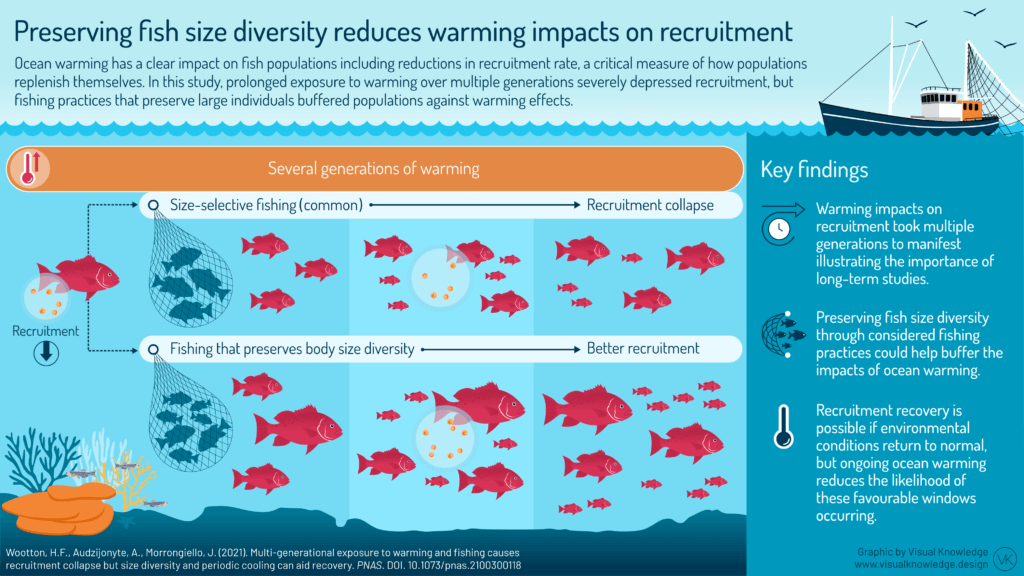
Dr Asta Audzijonyte
Questions answered by this expert
This is a great question, because we often think about the impacts of climate change on our favourite places and our homes. Tasmanian coastal waters and the Channel are some of the fastest warming areas in the world, also called the climate change hotspot. Apart from the warmer water for swimming and snorkelling, this also means that marine species and ecosystems are changing rapidly, and new species are arriving from further north. Some of these species are loved by anglers, such as the yellowtail kingfish. Other species are less welcome, such as the long-spined sea urchin. Unlike Tasmanian native urchins, these invading urchins can eat a lot of kelp, denuding kelp forests and creating urchin barrens. Kelp forests are disappearing also because of the heat waves and because the warmer waters and currents, reaching further from the mainland, have fewer nutrients.
Tasmania’s scientists and state government are aiming to preserve kelp forests by encouraging long-spined sea urchin harvest, breeding kelp that is more resilient to heat, and planting them back into the sea. The best thing we can do to increase resilience of marine ecosystems to climate change is to reduce pollution, restore natural habitats, such as seagrass and oyster reefs and, most importantly, ensure that the ecosystem has lots of large urchin eating fish and especially rock lobsters. Large fish and lobsters and important urchin predators and a natural control, and they do the work for us for free.
You can learn more about the kelp restoration efforts here - https://www.imas.utas.edu.au/news/news-items/restoring-tasmanias-giant-kelp-forests-the-focus-of-new-research-project
Here you can learn about seagrass restoration here - https://ozfish.org.au/projects/tasmania-seagrass-restoration-trial/
Or if you would like to learn more about new species that are arriving to Tasmania, you can check out and contribute to the citizen science empowered Redmap Australia - https://www.redmap.org.au/
Finally, here is a great site by Reef Life Survey researchers and volunteers, mapping the changes that are happening in reefs around the world. You can zoom into Tasmania and select “Location time series” option on the top, to view summaries for the Channel https://reeflifesurvey.com/explorer/map
This is a very good and important question, and a lot of scientists are asking and trying to understand that. Climate change brings many changes to the oceans. It changes temperature, food availability (in some places there is more food, in others less), how fast fish grow and how much they reproduce. All these impacts combine in complex ways, so that some fish species and some fisheries end up being winners and others might be losers. Generally, people in fisheries are used to changes and they can adapt to new conditions, especially if they work closely with scientists to regularly collect data and prepare for the future. In fact, Australian and Tasmanian fisheries are some of the few in the world who, together with the University of Tasmania, are developing climate adaptation plans.
Regarding the natural reproduction of fish, in warmer temperatures fish often mature and start reproducing earlier and at smaller size. Together with a team of colleagues, we have tried to address the very question of how climate change and fishing together will affect fish reproduction. We found that when our simulated fisheries removed the largest fish and these populations were also affected by warming, fish reproduction declined rapidly. In contrast, when fishing selectivity was changed and caught only the medium sized fish, warming didn’t have a negative effect on fish reproduction. You can see the summary of this experiment in the picture below. This experiment suggested that to increase fish resilience to climate change and protect their reproduction we should protect the largest fish in populations.

Tasmania is one of the marine global warming hotspots, which is big a challenge but also a potential opportunity for the Tasmanian fishing industry. Some important Tasmanian fisheries species might become less abundant and more vulnerable to climate extremes, but other species might benefit from warmer ocean and increase in abundance. Some fish species that are moving into Tasmanian waters already are or could become valuable fisheries species. The fishing industry can be sustainable if it adapts proactively, plans for the future and also supports marine protected areas to help improve resilience of fish populations. Actually, the Tasmanian fisheries industry is one of the few in the world that have conducted risk assessments, to see how climate change might affect them, and have already started some important adaptations (like actively fishing for a pesky urchin that has moved into Tasmania now that it is warm enough for it survive, but the urchin creates a problem by eating all the kelp habitat that lobsters need!).
One of the big questions for Tasmanian fisheries is how climate change will affect giant kelp forests. These forests are very important for fish and fisheries but are threatened by rising sea temperatures and the increasing sea urchin populations. Together with other management and fishing changes, marine protected areas could play an important role, as they help to rebuild the numbers of large fish and lobsters, which in turn keep the urchin numbers down.
You could read more about climate change adaptation research here.










